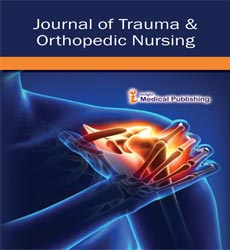Optimizing Postoperative Nursing Care in Hip Fracture Patients: Strategies for Enhanced Recovery
Karen Mitchell*
Department of Orthopaedic Nursing, Johns Hopkins Hospital, Baltimore, MD, USA
Received date: January 02, 2025, Manuscript No. ipton-25-20820; Editor assigned date: January 04, 2025, PreQC No. ipton-25-20820 (PQ); Reviewed date: January 15, 2025, QC No. ipton-25-20820; Revised date: January 20, 2025, Manuscript No. ipton-25-20820 (R); Published date: January 27, 2025, DOI: 10.36648/ipton.8.1.111
Citation: Mitchell K (2025) Optimizing Postoperative Nursing Care in Hip Fracture Patients: Strategies for Enhanced Recovery. J Trauma Orth Nurs Vol.8 No.1: 111.
Introduction
Hip fractures remain one of the most common and debilitating injuries among older adults, often associated with significant morbidity, mortality, and functional decline. Advances in surgical techniques have improved outcomes, but the postoperative phase is critical in determining long-term recovery. Nursing care plays a central role in ensuring enhanced recovery, as it addresses pain, mobility, psychosocial needs, and the prevention of complications. This article explores evidence-based nursing strategies that optimize recovery in hip fracture patients. Effective pain control is the cornerstone of postoperative care in hip fracture patients. Poorly managed pain can hinder early mobilization and rehabilitation, leading to prolonged immobility and higher complication risks. Nurses employ multimodal pain management strategies, including pharmacologic interventions such as opioids, nonsteroidal anti-inflammatory drugs, and regional anesthesia, along with non-pharmacologic methods like positioning, cold therapy, and relaxation techniques. Regular pain assessment using validated tools ensures tailored interventions [1].
Description
Early mobilization has been shown to improve functional outcomes and reduce hospital stay. Nurses collaborate with physiotherapists to initiate safe mobility as soon as possible, often within 24â??48 hours post-surgery. Encouraging activities such as bed-to-chair transfers, walking with assistance, and gradual strength-building exercises helps restore independence. Nurses also provide emotional encouragement, alleviating patient fears associated with movement after surgery. Postoperative complicationsâ??including deep vein thrombosis, pulmonary embolism, pressure ulcers, and infectionsâ??pose significant risks to hip fracture patients. Nurses play a critical role in prevention by ensuring adherence to prophylactic anticoagulant therapy, promoting leg exercises, and facilitating the use of compression devices. Frequent repositioning, skin inspections, and strict aseptic techniques during wound care reduce infection and pressure-related injuries [2].
Adequate nutrition accelerates wound healing and strengthens overall recovery. Many hip fracture patients, particularly older adults, are malnourished on admission. Nurses work with dietitians to assess nutritional status and develop individualized meal plans rich in protein, vitamins, and minerals. Supplementation with vitamin D and calcium may be recommended to support bone health. Ensuring hydration is equally important in reducing delirium risk and preventing urinary tract infections [3].
The psychological impact of hip fractures should not be underestimated, as patients often experience anxiety, depression, or fear of re-injury. Nurses provide reassurance, therapeutic communication, and counseling referrals when necessary. Encouraging family involvement and fostering social support networks enhance emotional well-being. Addressing psychological concerns not only improves adherence to rehabilitation but also contributes to a more positive recovery trajectory [4].
Older patients undergoing hip fracture surgery are at high risk for postoperative delirium, which can significantly delay recovery. Nursing interventions include maintaining a calm environment, minimizing unnecessary medications, promoting sleep hygiene, and encouraging orientation through clocks, calendars, and familiar objects. Regular cognitive assessments help detect early signs of delirium, enabling timely interventions to prevent long-term cognitive decline. Education is a cornerstone of enhanced recovery. Nurses provide comprehensive teaching on wound care, pain management, activity restrictions, use of mobility aids, and warning signs of complications. Educating families is equally important, as caregivers often play a crucial role in postoperative support at home. Empowering patients and families with knowledge fosters confidence and promotes adherence to recovery plans. Effective postoperative nursing care is enhanced through collaboration with surgeons, physiotherapists, dietitians, occupational therapists, and social workers. Nurses act as coordinators, ensuring continuity of care and seamless communication across disciplines [5].
Conclusion
Postoperative nursing care is integral to the recovery journey of hip fracture patients, encompassing pain management, early mobilization, complication prevention, and psychosocial support. By addressing both clinical and emotional needs, nurses facilitate smoother recovery and better long-term outcomes. Incorporating multidisciplinary collaboration, patient education, and ERAS principles strengthens the quality of care. As the population ages, optimizing postoperative nursing care will remain vital to improving survival, independence, and quality of life in hip fracture patients.
Acknowledgement
None.
Conflict of Interest
None.
References
- Friedman SM, Mendelson DA, Kates SL, McCann RM. (2008). Geriatric coâ?Âmanagement of proximal femur fractures: total quality management and protocolâ?Âdriven care result in better outcomes for a frail patient population. J Geriatr56: 1349-1356.
Google Scholar Cross Ref Indexed at
- Khasraghi FA, Christmas C, Lee EJ, Mears SC, Wenz SrJF. (2005). Effectiveness of a multidisciplinary team approach to hip fracture management. J Surg Orthop Adv14: 27-31.
- Meyer AC, Eklund H, Hedström M, Modig K. (2021). The ASA score predicts infections, cardiovascular complications and hospital readmissions after hip fracture-A nationwide cohort study. Osteoporos Int, 32(11: 2185-2192.
Google Scholar Cross Ref Indexed at
- Roche JJW, Wenn RT, Sahota O, Moran CG. (2005). Effect of comorbidities and postoperative complications on mortality after hip fracture in elderly people: Prospective observational cohort study. BMJ331: 1374.
Google Scholar Cross Ref Indexed at
- Ireland AW, Kelly PJ, Cumming RG. (2015). Total hospital stay for hip fracture: Measuring the variations due to pre-fracture residence, rehabilitation, complications and comorbidities. BMC Health Serv Res15: 17.
Open Access Journals
- Aquaculture & Veterinary Science
- Chemistry & Chemical Sciences
- Clinical Sciences
- Engineering
- General Science
- Genetics & Molecular Biology
- Health Care & Nursing
- Immunology & Microbiology
- Materials Science
- Mathematics & Physics
- Medical Sciences
- Neurology & Psychiatry
- Oncology & Cancer Science
- Pharmaceutical Sciences
